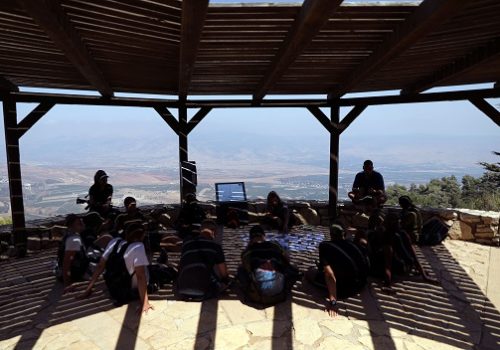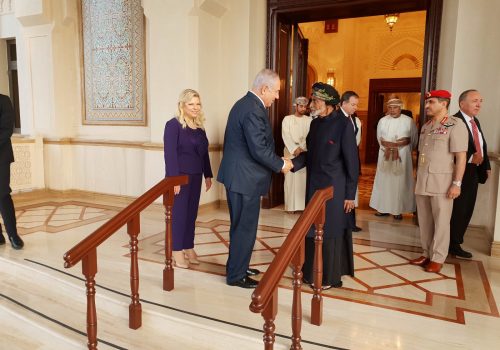Let’s make a deal of the century
The political segment of Peace to Prosperity, the Trump administration’s blueprint for Israeli-Palestinian peace, was released amid great fanfare on January 28. Drawing on US President Donald Trump as the equivocating barometer of the framework’s prospects for success, hopes for an immediate breakthrough toward a peace agreement between Israel and the Palestinians remain bleak.
Initial reactions to the purported “ultimate plan” disclose that all relevant parties to the bargain are digesting its parameters selectively and, like a horoscope, each in his own respective image. In the United States, Trump is celebrating the delivery of his promise to table a vision which he considers “the most serious, realistic, and detailed plan ever presented”—any drawbacks will be laid presumably at the feet of Israelis and Palestinians, and of limited concern to the author and the president’s “legacy”. Netanyahu, in his White House remarks, highlighted the proposal’s obvious and many indulgences of the Jewish state, but (un)comfortably sidestepped provisions included for the benefit of the Palestinians. Palestinian Authority President Mahmoud Abbas, meanwhile, has rejected the Trump offer out of hand as a “conspiracy.”
The path to this stunted outcome emerged slowly and in plain view. Over two years have passed since the Palestinian leadership in Ramallah engaged in substantive dialogue with the senior American officials responsible for the regional portfolio; Abbas suspended these contacts after the US recognized Jerusalem as Israel’s capital back in December 2017. From that point forward, while Abbas nursed grievances about having been treated unjustly by Washington, Netanyahu exploited the resulting vacuum adroitly and advocated for an arrangement on his own terms. Israel’s arguments found a welcome audience in Trump’s Republican cohort, and were rewarded periodically with trophies such as the relocation of the US Embassy to Jerusalem and American recognition of Israeli sovereignty over the Golan Heights.
Against this backdrop, the plan’s professed objective of propelling Israel and the Palestinians into direct negotiations will likely prove to be a bridge too far. A deep chasm of distrust separates them. For the Israeli government, the current landscape serves as proof of concept for its strategy to demonstrate to the Palestinians that time will not stand still for them, with changes on the ground making aspirations for Palestinian statehood decreasingly feasible. Indignant Palestinians, resentful of this predicament, can be expected to resist this attempt to goad them into dialogue—which, they believe, would be a waste of time anyhow.
These circumstances will only contribute to the confusion that already accompanies the minutiae of Trump’s program. His pronouncements that Jerusalem will remain the undivided capital city of Israel, but also house an eventual US embassy to a Palestinian state appear irreconcilable. Similarly, the president’s goal of a “realistic two state solution” would seem to collide with his commitment that “neither Israelis nor Palestinians will be uprooted from their homes.” It will be difficult to summon the agility that will be required to perform such diplomatic cartwheels absent the active involvement of the parties who, at present, are not even on speaking terms.
The impracticality of this scenario substantiates assessments that the January 28 rollout was not an exercise in peace mediation, but motivated rather by politics. The event could not have come at a more opportune time for two embattled leaders seeking re-election. Trump’s back-to-back meetings with Netanyahu and the prime minister’s primary rival, Benny Gantz—meetings which were the subject of great controversy in Israel, where Trump stands accused by some of interfering in national elections—played into suspicions that the president was acting as an accomplice in Netanyahu’s effort to divert the agenda from his corruption indictments. It was equally convenient for Trump to shift the frame from his impeachment hearings to the ostensible launch of a major international initiative. Notwithstanding, the festive atmosphere in the East Room was a boon to both Netanyahu and Trump whose core constituencies are strong supporters of the bond between their two countries.
Moving ahead, Israelis and Palestinians can be expected to retreat to their opposite corners in preparation for the next round. With Trump as referee, they will not be exploring the contours of a settlement, however, but the outer limits of American “permission” to act independently of each other.
Netanyahu is already rushing to implement parts of the US proposal and, in that vein, had called to convene Israel’s cabinet on February 2 for a vote on extending sovereignty to the Jordan Valley and to additional communities in the northern Dead Sea area. Trump’s acquiescence to the move removes what may have been the most powerful roadblock to a policy which Netanyahu has refrained from executing until now in the face of relentless pressure from his right-wing coalition partners, many of whom remain dissatisfied with continued talk of a future Palestinian state; any delays will incur their wrath surely. Netanyahu is also telegraphing that this initial step will be followed, after Israel’s March 2 election, by the similar annexation of other West Bank territories which the US has decided should be appended to Israel. Negative repercussions for Israel’s foreign and defense relations—most particularly, with the neighboring Kingdom of Jordan—are a definite risk.
Additionally, there are low US expectations of the Palestinians. Jared Kushner, son-in-law and senior advisor to the president, told CNN that they have “a perfect track record of blowing every opportunity they’ve had in their past.” Thus Netanyahu can be soundly confident that the administration will not express great objection as Israel continues to capitalize on American benevolence. From Trump’s perspective, Israel’s presentation of a “conceptual map,” together with declared American support for a “pathway” to Palestinian independence and the infusion of a $50 billion package of economic incentives toward achieving that objective, constitute a windfall for Abbas. After declaring it “only reasonable that I have to do a lot for the Palestinians, or it just wouldn’t be fair,” Trump stands almost certain to hold the Palestinian leader accountable for his refusal to embrace the US scheme.
Abbas has requested a meeting of the Arab League this weekend to mount a collective challenge to Trump’s plan. His chances of marshaling an Arab response are yet to be determined. Ambassadors of the UAE, Bahrain and Oman were honored participants at the White House event, and the cautious positioning of other US Middle East allies—in a constant balancing act against the threat of Iran—may lead to Abbas being compensated with little more than rhetorical backing. Either way, with the distinct possibility of renewed violence in the region, the deal of the century is off to an inauspicious and volatile start.
Shalom Lipner is a nonresident senior fellow for Middle East Programs.
Image: US President Donald Trump and Israel's Prime Minister Benjamin Netanyahu appear together to discuss a new Middle East peace plan proposal (Reuters)


